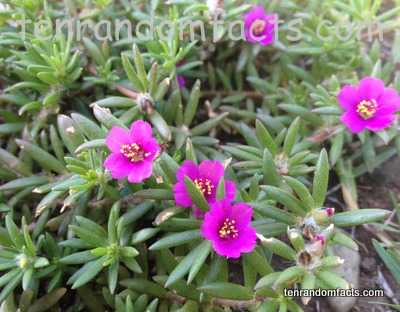The hairy portulaca’s way of growing is truly dependent on the climate.
- A hairy portulaca is a flowering species of annual succulent plant, that originated in the Americas, though it is sometimes grown as a perennial.
- ‘Hairy portulacas’ are also known as ‘hairy pigweeds’, ‘kiss-me-quicks’ and ‘akulikulis’, and they may also be called ‘moss roses’, although this title is also often used to refer to other species in the same genus.
- The scientific name of a hairy portulaca is Portulaca pilosa and it is from the family Portulacaceae, the family of purslanes.
- Hairy portulacas grow to be 5 to 20 centimetres (2 to 8 inches) in height and have a tendency to spread across the ground.
- Hairy portulacas mostly bloom in the summer months, and the flowers range from 0.5 to 1.5 centimetres (0.2 to 0.6 inches) in diameter and are coloured pink, purple or red.
- The growing habit of hairy portulacas depends on the climate, as warm and moist climates cause the plant to spread, while it tends to grow upwards in cooler and less moist climates.
- Numerous white hairs sprout from the branches of hairy portulacas, and the hairs tend to be more plentiful on plants in habitats with less water.
- Hairy portulacas are commonly used ornamentally, particularly to cover rocks or other surfaces like a mat, however in some parts of the world, including parts of Asia and Australia, the plant is considered a weed.
- Historically, hairy portulaca plants have been used to treat fevers or used for pain relief in traditional medicine in Brazil.
- Extract of the hairy portulaca plant is often used in some cosmetic products, and in particular, skin conditioning.
Bibliography:
Portulaca pilosa, 2013, Australian Portulaca, http://australianportulaca.blogspot.com.au/2013/01/portulaca-pilosa.html
Portulaca pilosa, 2015, Wikipedia, https://en.wikipedia.org/wiki/Portulaca_pilosa
Portulaca pilosa, n.d, Australian Tropical Rainforest Plants, http://keys.trin.org.au/key-server/data/0e0f0504-0103-430d-8004-060d07080d04/media/Html/taxon/Portulaca_pilosa.htm
Portulaca pilosa L. 1753, 2010, Some Magnetic Island Plants, http://www.somemagneticislandplants.com.au/index.php/plants/841-portulaca-pilosa






